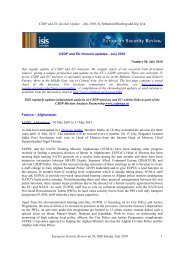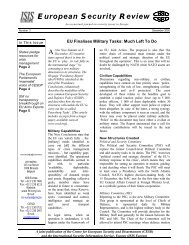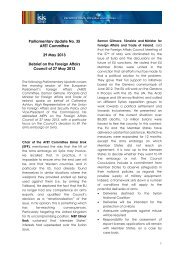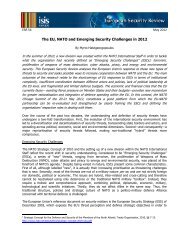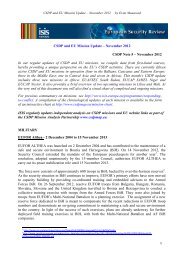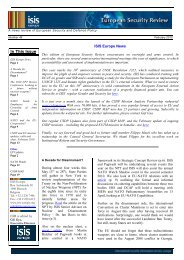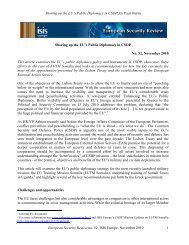the role of eu battlegroups for european defence - ISIS Europe
the role of eu battlegroups for european defence - ISIS Europe
the role of eu battlegroups for european defence - ISIS Europe
Create successful ePaper yourself
Turn your PDF publications into a flip-book with our unique Google optimized e-Paper software.
The EU Battlegroups, by Myrto Hatzigeorgopoulos<br />
cooperation and interoperability <strong>of</strong> EU armed <strong>for</strong>ces that <strong>the</strong> EU BGs aim at achieving is, thus, limited,<br />
while <strong>the</strong> military effectiveness <strong>of</strong> <strong>the</strong> BG concept but also <strong>of</strong> different BG <strong>for</strong>mations cannot be assessed<br />
in <strong>the</strong> absence <strong>of</strong> concrete operational experience.<br />
A last fundamental issue with regard to EU BGs’ operational capacity relates to <strong>the</strong> adequation between<br />
<strong>the</strong> tasks that <strong>the</strong>y have been set up <strong>for</strong> (i.e. extended Petersberg tasks & ESS), and <strong>the</strong>ir limited size,<br />
capabilities and sustainability. As warned by <strong>the</strong> EU Council Secretariat Factsheet on BGs, BGs can reach<br />
<strong>the</strong>ir “full potential in tasks <strong>of</strong> combat <strong>for</strong>ces in crisis management, bearing in mind <strong>the</strong>ir limited size”. 10<br />
As it has very widely been argued, “Battlegroups are not suited <strong>for</strong> stand-alone or prolonged deployment<br />
in high-intensity operations”. 11 There is indeed a significant capabilities-expectations gap, which<br />
practically renders EU BGs unlikely to handle stand-alone combat operations on <strong>the</strong> medium- to hard-end<br />
<strong>of</strong> military utility, especially given that no strategic reserve <strong>for</strong>ce <strong>for</strong> <strong>the</strong> EU BGs has been set up. Better<br />
suited <strong>for</strong> rapid pre-emptive operations limited both in space and time, EU BGs are probably more<br />
adapted to operate within a clearly delimited military and political framework and in a low to mediumintensity<br />
context, where “normal” <strong>for</strong>ces cannot be mobilised and deployed because <strong>of</strong> <strong>the</strong> urgency<br />
looming on normal <strong>for</strong>ce generation procedures.<br />
Political decision-making process and <strong>the</strong> question <strong>of</strong> deployment<br />
The problems arising from <strong>the</strong> fragmentation <strong>of</strong> <strong>the</strong> planning and decision-making structures and<br />
capacities are two-fold and inter-related; <strong>the</strong>y comprise both <strong>the</strong> national and <strong>Europe</strong>an political rustles<br />
within <strong>the</strong> planning and decision-making processes and structures <strong>the</strong>mselves, as well as <strong>the</strong> tight<br />
timeline assigned <strong>for</strong> rapid-response deployment. Indeed, a ra<strong>the</strong>r large number <strong>of</strong> actors and decisional<br />
levels are involved in <strong>the</strong> strategic and military planning and decision-making processes preceding a <strong>for</strong>ce<br />
deployment (c.f. Annex II). National caveats, legal requirements or lengthy procedures play an important<br />
<strong>role</strong>. With this regard, some progress has been reached by member states to facilitate and shorten<br />
procedures (c.f. inter-parliamentary cooperation <strong>of</strong> <strong>the</strong> NBG). However, planning, decision-making and<br />
command coordination between <strong>the</strong> EU and national levels remain clearly insufficient, 12 <strong>the</strong>reby hindering<br />
<strong>the</strong> EU BGs’ potential ability to react in due time and <strong>for</strong>m. Adequate synchronization <strong>of</strong> lengthy national<br />
decision-making processes with strained <strong>Europe</strong>an decision-making processes constitutes a primary<br />
challenge in a context where central planning and command capacities at <strong>the</strong> political-strategic level, in<br />
Brussels, are only limited. However, <strong>the</strong> recent first-ever activation <strong>of</strong> <strong>the</strong> EU Operations Centre (Ops<br />
Centre, established on 1 January 2007) “to improve coordination and streng<strong>the</strong>n civil-military synergies<br />
between <strong>the</strong> three CSDP actions in <strong>the</strong> Horn <strong>of</strong> Africa” 13/14 , on 23 March 2012, may potentially impact <strong>the</strong><br />
issue <strong>of</strong> <strong>Europe</strong>an fragmentation <strong>of</strong> <strong>the</strong> planning and command structure. The efficiency and outcomes <strong>of</strong><br />
this first utilisation <strong>of</strong> <strong>the</strong> Ops Centre is likely to pave (or block) <strong>the</strong> way towards <strong>the</strong> provision <strong>of</strong> suitable<br />
EU Operational Headquarters.<br />
10 EU Council Secretariat Factsheet, «EU Battlegroups», EU BG 02, November 2006<br />
11 Claudia Major & Christian Mölling, Ibid., p. 19<br />
12 Ibid., p. 6<br />
13 Factsheet – “The activation <strong>of</strong> <strong>the</strong> EU Operations Centre”,<br />
http://www.consilium.<strong>eu</strong>ropa.<strong>eu</strong>/media/1634515/factsheet_opscentre_22_may_12.pdf<br />
14 The EU is currently conducting a military operation (EUNAVFOR Operation ATALANTA) and a military<br />
mission (EU Training Mission Somalia – EUTM Somalia). The planning <strong>of</strong> <strong>the</strong> civilian mission (EUCAP<br />
NESTOR) is in its final stage and <strong>the</strong> mission we be launched over <strong>the</strong> summer 2012.<br />
<strong>ISIS</strong> EUROPE ESR 56 June 2012



